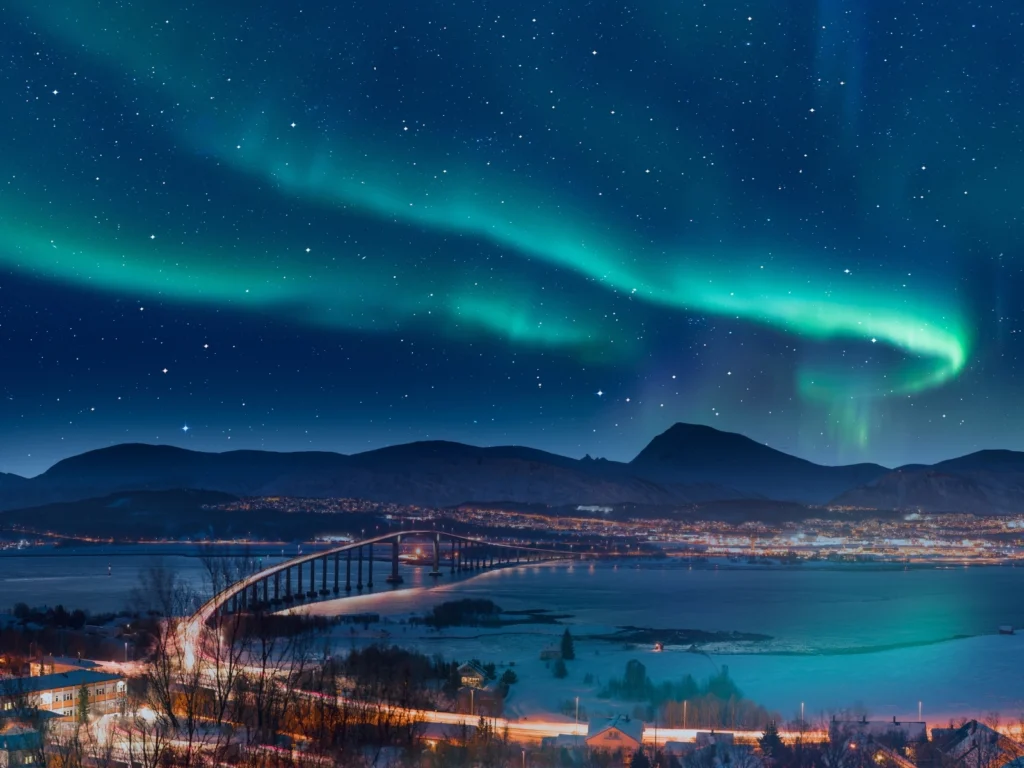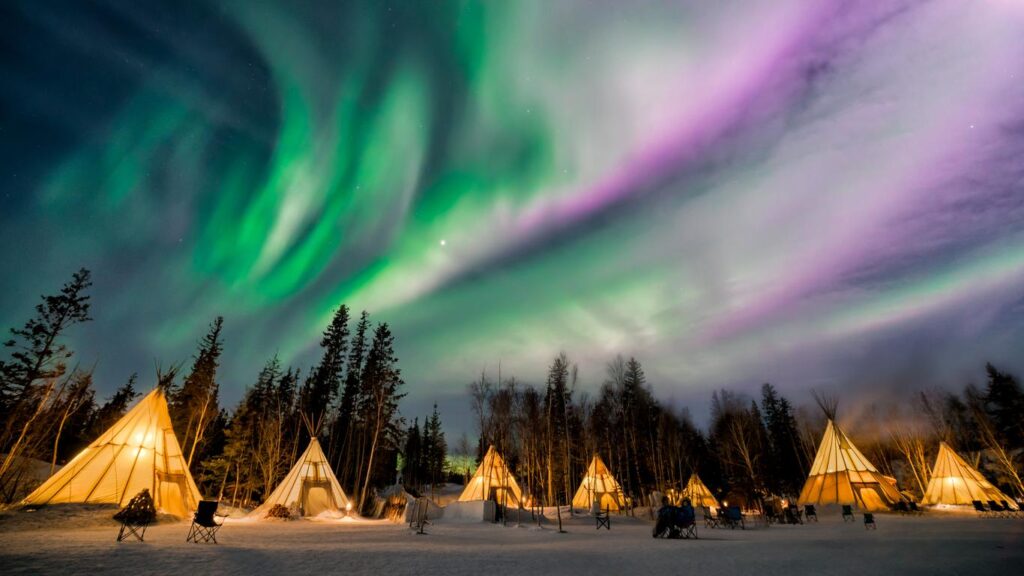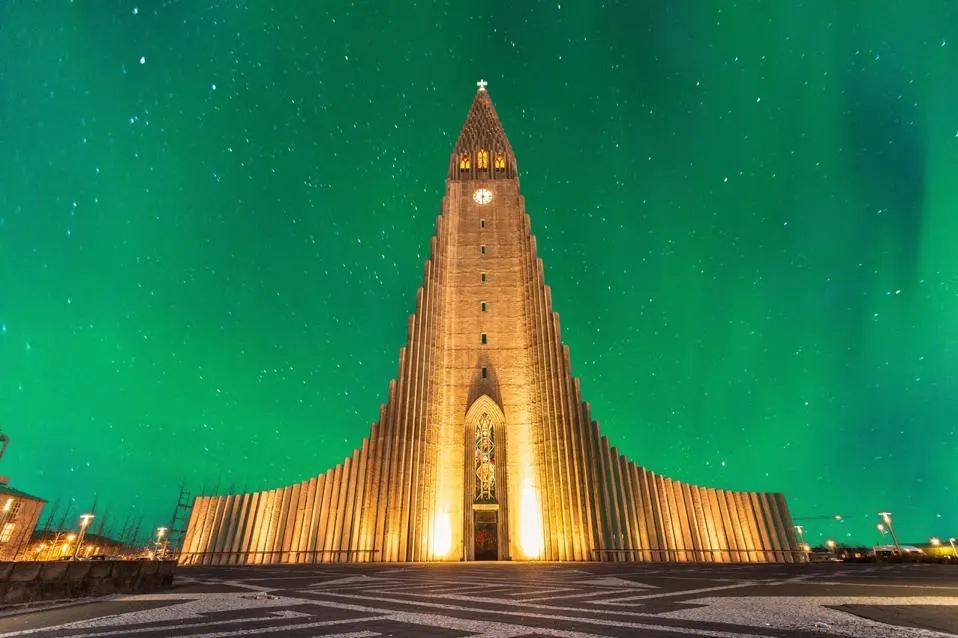The northern lights, known as the aurora borealis, are a spectacular natural light show visible at certain times of the year in the Northern Hemisphere. They occur when electrically charged particles from the sun collide with gases in the Earth’s atmosphere, creating vibrant streaks of blue, green, pink and violet dancing across the night sky. 2024 and 2025 are an excellent time to catch the northern lights: Solar activity will be at a peak, making for a more impressive experience, if you’re in the right place.
The best places to see the aurora borealis have little light pollution, clear skies and no precipitation. The lights are only visible at northern latitudes when it’s dark outside, so the months from September to April are best for seeing the aurora. There’s also a Southern Hemisphere counterpart, the aurora australis; there are fewer easy spots from which to view this phenomenon, but if you’re lucky, it can be equally brilliant.
Fairbanks, Alaska, is a prime destination for witnessing the northern lights, thanks to its unique location directly under the auroral oval. This zone, encircling the Earth’s geomagnetic North Pole, offers some of the most vivid aurora sightings globally. Visitors have a high chance of seeing the lights on four out of five clear nights during the aurora season, which spans from late August to late April.
One of the best ways to experience the northern lights in Fairbanks is by booking a tour that includes a visit to Chena Hot Springs Resort. This excursion provides round-trip transportation from Fairbanks, allowing you to relax in the warm waters of the hot springs while watching the aurora dance overhead. The tour also includes a visit to the Fairbanks Aurora Ice Museum and an aurora viewing session. You can enhance your experience with optional dinner and drinks featuring local Alaskan produce, with hot beverages included to keep you warm
Tromsø, situated about 220 miles above the Arctic Circle, is one of Norway’s premier locations for viewing the northern lights. During the aurora season, which lasts from September to early April, the region experiences extended periods of darkness, particularly at its peak when the sun doesn’t rise, though twilight provides a soft glow during the day. This near-constant darkness significantly increases the chances of witnessing the mesmerizing aurora.
While Tromsø is a small city, it’s full of life and offers plenty to explore when you’re not chasing the lights. One must-see landmark is the Arctic Cathedral, known for its striking architecture and serene ambiance. If you visit between late January and early February, you can immerse yourself in the Northern Lights Festival, a 10-day celebration of music and performing arts featuring various genres. For the best aurora viewing, it’s advisable to move away from the city’s light pollution. While you can try spotting the lights on your own, joining a guided tour can enhance your experience. Arctic Circle Tours offers small group excursions, providing a more intimate and personalized adventure.
For a more secluded aurora experience, consider heading 70 miles north of Rovaniemi to Luosto, a resort town nestled within the scenic Pyhä-Luosto National Park. The area is known for its rolling hills and picturesque landscapes, making it an idyllic setting for a night under the stars. One of the most magical ways to experience the northern lights here is by taking a reindeer-drawn sleigh ride through the snow-covered forests. Jaakkola Reindeer Farm offers a weekly reindeer sleigh tour, where you can watch the aurora while wrapped in blankets under the open sky.
Yellowknife, the capital of Canada’s Northwest Territories, proudly claims the title of the “Aurora Capital of the World.” Its prime location in the heart of the auroral oval makes it one of the best places on the planet to witness the northern lights. The ideal time to see the aurora is from mid-November to early April, but the lights are visible up to 240 days a year, meaning you might even catch a glimpse during the milder weather of late summer to early fall.
Situated on the northern shore of Great Slave Lake, Yellowknife offers more than just aurora viewing. The city is a hub for winter sports, including ice fishing and cross-country skiing. If you visit in March, you can experience the Snowkings’ Winter Festival, a month-long celebration that includes snow-carving competitions, a snow castle, live music, and various other activities that capture the spirit of the season. For a truly memorable northern lights experience, consider booking a tour with Aurora Village. This Aboriginal-owned property offers a comfortable and immersive way to enjoy the aurora. They provide round-trip transportation from your hotel to their site, where you can stay warm in heated tents while sipping hot beverages and waiting for the lights to appear.
October through March is the prime time to chase the aurora borealis in Iceland, when the long and dark winter nights provide ideal conditions for witnessing this natural phenomenon. While there are numerous natural parks and attractions throughout the country where you can view the northern lights, Reykjavik, the capital city, also offers plenty of options for accommodations, dining, tours, and other activities to enhance your visit.
For the best aurora viewing in Reykjavik, away from the city’s light pollution, head to Öskjuhlið. This wooded and hilly area, located about 200 feet above sea level, features walkways and paths perfect for enjoying the nighttime light show. At the top of this hill sits Perlan, a landmark building that houses Iceland’s only planetarium, along with a museum showcasing exhibits about the country’s natural wonders. Perlan is also home to the world’s first indoor ice cave and glacier exploratorium. While you’re there, be sure to visit the fourth-floor observation deck, which offers panoramic views of Reykjavik and its surroundings, including the Snæfellsjökull glacier, the volcanic mountain Keilir, and the iconic Esja mountain.












